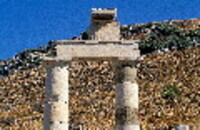| dc.coverage.spatial | Site: Ephesus, Aegean Region, Turkey | en_US |
| dc.coverage.temporal | ca. 60 BCE-30 CE (creation) | en_US |
| dc.creator | unknown (Ancient Roman) | en_US |
| dc.date | -60-30 | en_US |
| dc.date.accessioned | 2013-02-26T20:49:09Z | |
| dc.date.available | 2013-02-26T20:49:09Z | |
| dc.date.issued | -60-30 | en_US |
| dc.identifier | 196379 | en_US |
| dc.identifier.other | archrefid: 1561 | en_US |
| dc.identifier.uri | http://hdl.handle.net/1721.3/103890 | |
| dc.description | Ruins north side, looking northeast, showing Doric architrave; The Prytaneion [Gr.: 'town hall'] was a type of civic structure built in most ancient Greek towns around the 7th to the 4th century BC, although the first prytaneion in Athens was probably built in the 9th-8th century BC. It served as a place where official guests dined at the expense of the state, as a law court, a social welfare institution, an archive office and a place of asylum. Its religious significance stemmed from the presence in it of the perpetual fire of the goddess Hestia, which symbolized the existence of the city. Prytaneia are referred to in inscriptions in more than 100 Greek city states. At Ephesus Roman remains of the Augustan period include the aqueduct for the Marnas water supply; the Doric vestibule of the prytaneion with the Hestia hall and the double temple next to the prytaneion. The Doric order is rare at Ephesos. Source: Grove Art Online; http://www.oxfordartonline.com/ (accessed 7/8/2008) | en_US |
| dc.format.medium | stone | en_US |
| dc.rights | © Scott Gilchrist, Archivision, Inc. | en_US |
| dc.subject | architectural exteriors | en_US |
| dc.subject | Roman Empire | en_US |
| dc.subject | government | en_US |
| dc.subject | civic structure | en_US |
| dc.subject | community | en_US |
| dc.subject | Imperial (Roman) | en_US |
| dc.title | Prytaneion | en_US |
| dc.title.alternative | Ephesus: Prytaneion | en_US |
| dc.type | image | en_US |
| dc.rights.access | Licensed for educational and research use by the MIT community only | en_US |
| dc.identifier.vendorcode | 1A3-R-T-E-12-C3 | en_US |
| vra.culturalContext | Ancient Roman | en_US |
| vra.technique | construction (assembling) | en_US |
| vra.worktype | city hall | en_US |
| vra.worktype | excavation (site) | en_US |
| dc.contributor.display | unknown (Ancient Roman) | en_US |



